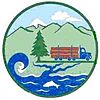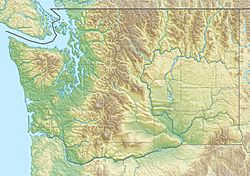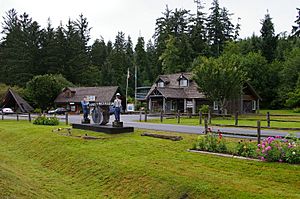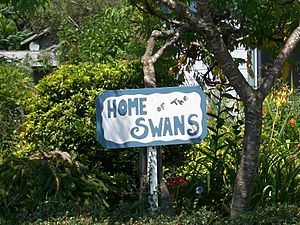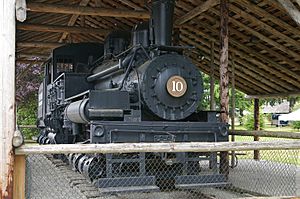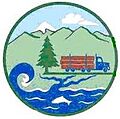Forks, Washington facts for kids
Quick facts for kids
Forks, Washington
|
||
|---|---|---|
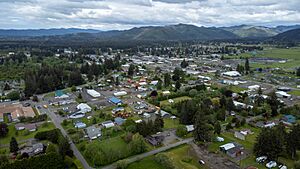
Aerial view of Forks
|
||
|
||
| Nickname(s):
Logging Capital of the World
|
||
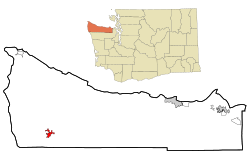
Location in the state of Washington
|
||
| Country | United States | |
| State | Washington | |
| County | Clallam | |
| Incorporated | August 7, 1945 | |
| Government | ||
| • Type | Mayor–council | |
| Area | ||
| • Total | 4.12 sq mi (10.67 km2) | |
| • Land | 4.12 sq mi (10.67 km2) | |
| • Water | 0.00 sq mi (0.00 km2) | |
| Elevation | 305 ft (93 m) | |
| Population
(2020)
|
||
| • Total | 3,335 | |
| • Density | 810/sq mi (312.6/km2) | |
| Time zone | UTC-8 (PST) | |
| • Summer (DST) | UTC-7 (PDT) | |
| ZIP Code |
98331
|
|
| Area code | 360 | |
| FIPS code | 53-24810 | |
| GNIS feature ID | 1519696 | |
Forks is a city in Washington, United States. It's located in the southwest part of Clallam County. In 2020, about 3,335 people lived there. The city gets its name from the nearby Bogachiel, Calawah, and Sol Duc rivers. These rivers join to form the Quillayute River.
For many years, Forks was known for its timber industry. More recently, it became famous because of the Twilight books and movies. These stories are set in Forks. The city also gets jobs from nearby prisons and is a popular spot for fishing. People come to fish for salmon and steelhead trout in the rivers. Visitors to Olympic National Park also help the local economy.
Contents
History of Forks
Early Days with Native Americans
Forks was once home to the Quileute Native American tribe. They lived there before giving up their land. In 1889, a special area called a reservation was created for them. This happened the same year Washington became a state. The name "Forks Prairie" comes from a Quileute phrase meaning "prairie upstream."
How Forks Began
The first settlers came to Forks by rivers and trails. It was hard to travel by land back then. In 1878, Luther and Esther Ford arrived and started a homestead. They also set up the first dairy farm in 1879. A post office opened in 1884. The name 'Forks' was chosen because the area was near where three rivers met.
It was tough to sell goods from Forks at first. The closest market was far away in Port Townsend. Roads were built in the late 1800s and early 1900s, which made things a bit easier. Eventually, a car-sized road opened in 1927. The main highway, U.S. 101, was built through Forks in 1931.
Settlers and loggers started clearing timber in the late 1800s. Large logging camps were set up in the early 1900s. These camps brought many workers to the area. During World War I, there was a high demand for Sitka spruce wood. The U.S. Army built a railroad to transport this wood. Forks grew steadily, gaining modern services in the 1920s and 1930s. The local newspaper, Forks Forum, began in 1930.
Modern Times in Forks
Forks officially became a city on August 7, 1945. The local timber industry grew a lot from the 1950s to the 1970s. Forks even called itself the "Logging Capital of the World." But changes in environmental rules caused the timber industry to slow down in the 1980s and 1990s. Logging still happens today, but not as much as before.
The city became very famous because of Stephenie Meyer's Twilight books. These books were published from 2005 to 2008. The movies based on the books came out from 2008 to 2012. Forks was the main setting for these popular stories.
People of Forks
| Historical population | |||
|---|---|---|---|
| Census | Pop. | %± | |
| 1950 | 1,120 | — | |
| 1960 | 1,156 | 3.2% | |
| 1970 | 1,680 | 45.3% | |
| 1980 | 3,060 | 82.1% | |
| 1990 | 2,862 | −6.5% | |
| 2000 | 3,120 | 9.0% | |
| 2010 | 3,532 | 13.2% | |
| 2020 | 3,335 | −5.6% | |
| U.S. Decennial Census 2015 Estimate |
|||
In 2010, Forks had 3,532 people living there. About 67.7% of the people were White. Around 6.6% were Native American, and 18.1% were from other races. About 25.9% of the population was Hispanic or Latino.
The average age in Forks was 31.3 years old. About 29.2% of the people were under 18. And 9.7% were 65 years or older.
Geography and Weather
Forks is located on Forks Prairie. It's just east of where the Calawah River and Bogachiel River meet. U.S. Route 101 goes right through the town. The city is surrounded by the Olympic rainforest.
Forks has a wet, mild climate. It's a temperate rainforest area. It gets over 100 inches of rain every year. Even in summer, it rains a lot, but less than other seasons. Forks has measurable rain on about 212 days each year.
| Climate data for Forks, Washington (1991–2020 normals, extremes 1907–present) | |||||||||||||
|---|---|---|---|---|---|---|---|---|---|---|---|---|---|
| Month | Jan | Feb | Mar | Apr | May | Jun | Jul | Aug | Sep | Oct | Nov | Dec | Year |
| Record high °F (°C) | 67 (19) |
75 (24) |
81 (27) |
85 (29) |
96 (36) |
110 (43) |
101 (38) |
102 (39) |
100 (38) |
88 (31) |
73 (23) |
65 (18) |
110 (43) |
| Mean maximum °F (°C) | 55.4 (13.0) |
59.8 (15.4) |
66.0 (18.9) |
72.8 (22.7) |
81.2 (27.3) |
84.5 (29.2) |
88.2 (31.2) |
88.5 (31.4) |
83.6 (28.7) |
71.8 (22.1) |
58.6 (14.8) |
54.1 (12.3) |
93.0 (33.9) |
| Mean daily maximum °F (°C) | 46.9 (8.3) |
49.9 (9.9) |
53.3 (11.8) |
58.7 (14.8) |
64.5 (18.1) |
68.0 (20.0) |
73.1 (22.8) |
74.0 (23.3) |
70.1 (21.2) |
60.0 (15.6) |
50.6 (10.3) |
45.6 (7.6) |
59.6 (15.3) |
| Daily mean °F (°C) | 40.7 (4.8) |
42.0 (5.6) |
44.4 (6.9) |
48.3 (9.1) |
53.6 (12.0) |
57.5 (14.2) |
61.6 (16.4) |
62.3 (16.8) |
58.8 (14.9) |
51.2 (10.7) |
44.0 (6.7) |
39.8 (4.3) |
50.4 (10.2) |
| Mean daily minimum °F (°C) | 34.6 (1.4) |
34.0 (1.1) |
35.6 (2.0) |
37.9 (3.3) |
42.7 (5.9) |
47.0 (8.3) |
50.2 (10.1) |
50.5 (10.3) |
47.4 (8.6) |
42.4 (5.8) |
37.5 (3.1) |
34.0 (1.1) |
41.2 (5.1) |
| Mean minimum °F (°C) | 23.3 (−4.8) |
24.3 (−4.3) |
26.6 (−3.0) |
29.5 (−1.4) |
33.5 (0.8) |
39.4 (4.1) |
42.9 (6.1) |
43.1 (6.2) |
38.0 (3.3) |
31.2 (−0.4) |
25.2 (−3.8) |
23.4 (−4.8) |
19.8 (−6.8) |
| Record low °F (°C) | 3 (−16) |
8 (−13) |
12 (−11) |
21 (−6) |
25 (−4) |
30 (−1) |
34 (1) |
34 (1) |
24 (−4) |
21 (−6) |
8 (−13) |
3 (−16) |
3 (−16) |
| Average precipitation inches (mm) | 19.10 (485) |
11.69 (297) |
14.31 (363) |
9.43 (240) |
4.96 (126) |
3.69 (94) |
2.05 (52) |
2.77 (70) |
4.77 (121) |
11.71 (297) |
18.07 (459) |
17.39 (442) |
119.94 (3,046) |
| Average snowfall inches (cm) | 3.1 (7.9) |
1.3 (3.3) |
0.5 (1.3) |
0.1 (0.25) |
0.0 (0.0) |
0.0 (0.0) |
0.0 (0.0) |
0.0 (0.0) |
0.0 (0.0) |
0.0 (0.0) |
1.0 (2.5) |
1.9 (4.8) |
7.9 (20.05) |
| Average precipitation days (≥ 0.01 in) | 23.0 | 20.2 | 23.2 | 20.4 | 15.9 | 15.7 | 10.2 | 9.4 | 11.5 | 18.7 | 23.2 | 23.7 | 215.1 |
| Average snowy days (≥ 0.1 in) | 1.6 | 0.9 | 0.8 | 0.2 | 0.0 | 0.0 | 0.0 | 0.0 | 0.0 | 0.0 | 0.6 | 1.0 | 5.1 |
| Source 1: NOAA | |||||||||||||
| Source 2: National Weather Service | |||||||||||||
Quillayute Airport
Getting Around Forks
Forks has its own airport, Forks Municipal Airport. It's about 1 mile southwest of the city. The airport has one runway, which is 2,400 feet long. It's used by small planes and helicopters.
Public buses also serve Forks. Clallam Transit has local routes within Forks. It also connects Forks to other towns like Port Angeles and La Push. Another bus service, Jefferson Transit, goes south of Forks on Highway 101. You can transfer to other buses from there. All these bus routes run six days a week.
News and Radio
Forks has two newspapers. One is the Peninsula Daily News. The other is the weekly Forks Forum. This paper is known as the "farthest west newspaper" in the mainland United States.
For radio, KBDB-FM 96.7 is the local commercial station. KNWU 91.5 is a public radio station. It's part of the statewide Northwest Public Radio network.
Schools and Learning
Forks is part of the Quillayute Valley School District. Forks High School is the main high school in the community. The University of Washington also has a special center in Forks. It's called the Olympic Natural Resources Center.
Economy and Fun Things to Do
Forks is changing from a logging town to a place that attracts tourists. The Forks Timber Museum is a great place to learn about the area's logging history. It was built in 1989 by students from Forks High School. The museum shows what the timber industry was like and the tools loggers used. It also has exhibits about local history from the 1870s.
Forks is a good starting point for trips to nature. You can visit the Hoh Rainforest or the Pacific Beaches. There are also many wilderness trails nearby. Forks is very popular for winter steelhead fishing. People fish in the Quillayute river system, which includes the Hoh, Sol Duc, Bogachiel, and Calawah rivers. You can also fish for king salmon in other nearby rivers. Local guides and fishing gear are available in town.
Another big reason people visit Forks is the Twilight book and movie series. The author, Stephenie Meyer, chose Forks as the setting because she looked for a rainy place online. You can take tours to see places that look like those described in the books. Most of the movies were not filmed in Forks, but some important scenes were.
The number of tourists visiting Forks grew a lot after the Twilight series became popular. In December 2005, only 74 visitors signed the guest book. By December 2009, that number jumped to 2,540. In July 2009, it was 16,186 visitors! Before Twilight, about 10,000 tourists visited each year. By 2010, that number grew to 73,000.
Tillicum Park
In Tillicum Park, Forks has a special train engine called a Shay engine. These engines are unique because they have a crankshaft on the side that powers all their wheels. They were made to carry lumber out of forests. The Shay engine in Forks was built in 1930. It was used for logging near Forks until 1959.
The Forks Lions Club built a nice shelter over the engine in 1999. They have also helped build and take care of many other things in Tillicum Park for over 40 years.
Fun Community Events
- Rainfest: This arts and crafts festival happens in April. It includes art shows and quilt classes.
- Quillayute Valley Scholarship Auction: Every March, this event raises lots of money for student scholarships. Since 1964, over $1 million has been given to Forks students!
- Old Fashioned Fourth of July: In the summer, Forks celebrates with a big parade. There's also a demolition derby and fireworks.
- Quileute Days: Also in July, this event at La Push celebrates Quileute culture. It has a parade, traditional salmon bake, and canoe races.
- Forks Family Festival: In August, this festival offers arts and crafts and activities for kids.
- Last Chance Fishing Derby: In late September, you can join this fishing contest for salmon. There are cash prizes!
- Heritage Days: The first week of October celebrates Forks' history. A popular event is the "Old Timers Round Table." Longtime residents share stories on the local radio.
- Forever Twilight in Forks Festival: This festival happens annually around September 13. It celebrates the Twilight series. Events include movie marathons, a blood drive, and dance lessons. This festival continues to bring many tourists to Forks.
Images for kids
See also
 In Spanish: Forks para niños
In Spanish: Forks para niños


